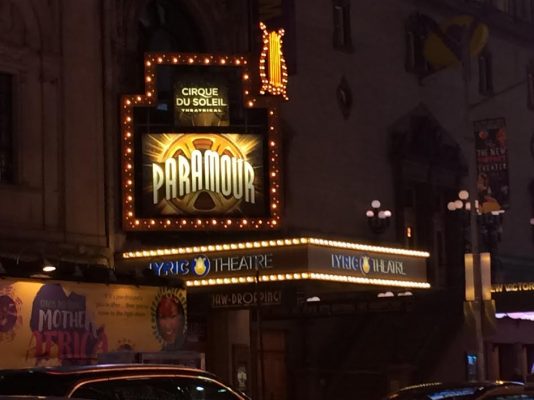Paramour: A Show-Stopper or a Show that Needs to Stop?
November 5, 2016
In Manhattan, tourists and locals alike turn to Broadway for performances they will never forget. This year, Cirque du Soleil has its turn to occupy a spot in the Theater District, opening its first New York show titled “Paramour.” “Paramour,” while containing acrobatics in the tradition of Cirque du Soleil, chose to diverge from the company’s typical formula and instead takes on the structure of a traditional Broadway musical. A risk like this may or may not pay off, and unfortunately, “Paramour” was a risk that does not end in victory.
Set in the “Golden Age” of Hollywood, “Paramour” follows the story of A.J. Golden (Jeremy Kushnier), a successful director who is in search for a new leading lady. His prayers are answered when he discovers a bar singer named Verna (Ruby Lewis), a small-town girl with big dreams, who he renames “Indigo” and transforms into his star. A relationship begins to blossom between them as her popularity grows, but when Verna’s childhood friend Joey (Ryan Vona) admits he loves her, she is forced to choose between the man who made her a star and the man she truly loves. Sounds cliché? That’s because it is.
The performance’s entire plot centers around this love triangle, and sadly it does not deliver. The plot is utterly predictable, making nearly every moment that the actors appear on stage monotonous. From a lovestruck Joey playing his guitar under Verna’s window and offering her the “simple life,” to A.J. Golden bribing her with money and fame, the audience sees more romantic clichés than actual character development.
The music was no better. Forced to compliment the clichéd plotline, the lyrics and melodies sounded just as overused and repetitive as the plot itself.
In terms of acting and singing, the performers were good, but they were not spectacular enough to take the type of lead that the musical required of them. Even the ensemble made their fair share of mistakes in the performance, occasionally dancing out of sync and forgetting their cues.
It seems that “Paramour” made the mistake of relying too heavily on their actors when it was the acrobatics that truly shined. In most scenes, the acrobats were reduced solely to background entertainment while the leads were performing, causing a confusing experience for audience members. With so many on stage at the same time, it is hard to find one thing to focus on completely. However, when the opportunity arose for the acrobats to take center stage, they literally soared to new heights. From bouncing on a seesaw and flipping over twenty feet in the air, to dancing a tango suspended over a highwire, the acrobats stole the show whatever chance they could.
Furthermore, in an attempt to mold the acrobatic skill of Cirque du Soleil into a stereotypical Broadway musical, “Paramour” lacks the spectacle that the company’s shows typically contain. By focusing almost exclusively on the lead actors, the performance reduced the acrobats, the main draw for many, to the background. Therefore, it seemed to resemble a mediocre Broadway play more than a spectacle. Perhaps if the show utilized the acrobats more, it would truly live up to the vision it advertises.
One aspect of “Paramour” that excelled were its sets. Designed by Jean Rabasse, each scene had its own unique backdrop that contributed to its old Hollywood theme. One of the highlights of the performance was a sequence based on Elizabeth Taylor’s “Cleopatra,” with mile-high display pieces that truly transported the viewer to the Ancient Egypt only seen in movies. Many set pieces were also multi-functioning for quick changes, which was extremely fun to witness.
“Paramour” also made use of computer technology to tell its story. Many of the set pieces were white, which in turn allowed different projections to appear and mimic anything from high speed chases to unique camera angles. Drones were also used to create a dream sequence between IVerna and Joey, proving that technology does have the capability to work seamlessly with actors on stage. Furthermore, it was interesting to see projection technology effortlessly combine with the plot to produce a story.
Overall, while “Paramour” did produce incredible acrobatics and sets that were as glamorous as Hollywood itself, the production sorely lacked a convincing plotline. Perhaps director Philippe Decouflé should have focused on highlighting the talent of his acrobats rather than modifying the play to fit in with the rest on Broadway. In that way, the show would truly transform into something unique, and it could gain the recognition that it sorely needs.










